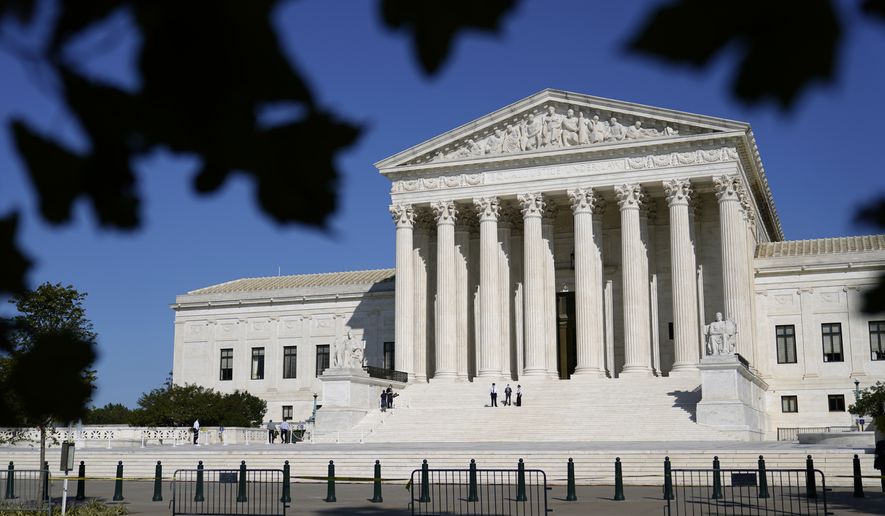The vote count in the Senate shows Republicans can squeak through a confirmation of President Trump’s Supreme Court pick, now that anti-Trump leader Sen. Mitt Romney has pledged to help advance the nominee.
The move gives President Trump the green light as he plans to announce his pick Saturday to replace the late Justice Ruth Bader Ginsburg.
“I’m getting very close to having a final decision made, very close,” Mr. Trump told reporters at the White House, adding that the country needs a full bench of nine justices before the election in case the results are contested.
“We need nine justices. You need that with the unsolicited millions of ballots that they’re sending. It’s a scam. It’s a hoax. Everybody knows that. And the Democrats know it better than anybody else.”
Mr. Romney said he was following the Constitution and precedent in helping advance the process.
“If the nominee reaches the Senate floor, I intend to vote based upon their qualifications,” the Utah Republican said.
Mr. Romney’s support for moving the confirmation process forward so close to the Nov. 3 elections was a surprise. He was the lone Republican senator to break with his party and vote to convict Mr. Trump and remove him from office this year on one of the impeachment charges and has opposed the president at nearly every turn.
With Mr. Romney’s support, Republicans have enough votes to push through a nominee without bipartisan help, and Democrats have no procedural tools to stop them.
The Senate rules put the Republican majority in the driver’s seat, Democratic senators acknowledged.
“If there had been some triple-secret procedural device, we likely would have used it with Gorsuch and Kavanaugh,” said Sen. Sheldon Whitehouse, Rhode Island Democrat and a member of the Senate Judiciary Committee. “The idea that we have one and didn’t bother to use it in those last two confirmations seems a little bit of a stretch.”
Republicans have secured 51 votes to advance the process with just about 40 days until Election Day. The power play leaves Senate Democrats with no way to slow the vote in hopes that Joseph R. Biden wins the presidency on Nov. 3, allowing him to argue that he should fill the high court vacancy left by the liberal icon.
The stakes couldn’t be higher for a Supreme Court battle. The confirmation of a conservative Trump nominee would dramatically alter the balance of the court to a 6-3 split.
Democrats are loath to let that happen.
House Speaker Nancy Pelosi, California Democrat, said over the weekend that her chamber would use “every arrow in our quiver” to try to delay the Senate from pushing through a nominee before the election. She didn’t rule out impeaching Mr. Trump or Attorney General William Barr.
But Democratic Caucus Chairman Hakeem Jeffries of New York downplayed that option Tuesday.
“At the current moment, we’re looking forward to the election. Health care is on the ballot. Civil rights is on the ballot. Decency is on the ballot. Unity is on the ballot. And the American people will ultimately make the decision as to whether Trump and his corrupt administration should be held accountable,” the New York Democrat told reporters.
“But I don’t think we’re contemplating anything other than to say that all options are on the table,” he said.
Mr. Trump pledged to nominate a woman and has a short list of five candidates:
• Judge Amy Coney Barrett of the 7th U.S. Circuit Court of Appeals.
• Judge Barbara Lagoa of the 11th U.S. Circuit Court of Appeals.
• Judge Joan Larsen of the 6th U.S. Circuit Court of Appeals.
• Judge Allison Jones Rushing of the 4th U.S. Circuit Court of Appeals.
• Kate Todd, deputy counsel to the president.
Judges Barrett and Lagoa appear to be the leading candidates, according to sources familiar with the president’s thinking.
Even if the Democratic members of the Senate Judiciary Committee refuse to show up at the confirmation hearing in an attempt to deny a quorum, the Republican majority still could hold the hearing.
Where the Democrats may have a leg up is when the committee meets to mark up the nominee, which usually occurs a week or two after the hearing. Committee rules suggest at least two Democrats would need to be present to vote the nominee out of committee and to the full Senate floor for a final confirmation vote.
But the Republican majority would have ways around that, such as changing the quorum requirement or moving the nomination straight to the full chamber.
Democrats, lacking the resources to halt the process, have threatened blowback against Republicans if they move forward with filling the vacancy. They said they could pack the Supreme Court with more justices to counter the conservative majority if Democrats win the White House and Senate.
They also have threatened to eliminate the legislative filibuster, a tool that requires 60 votes in the Senate to move forward with debate on a bill. The legislative filibuster has long been aimed at requiring bipartisan support for any bill that passes the upper chamber.
Senate Majority Leader Mitch McConnell, Kentucky Republican, bucked the threat to pack the Supreme Court. He noted that liberals have been pushing court-packing for months.
• Alex Swoyer can be reached at aswoyer@washingtontimes.com.




Please read our comment policy before commenting.